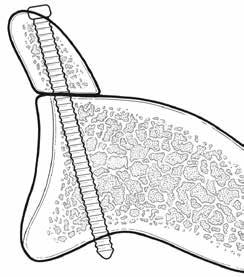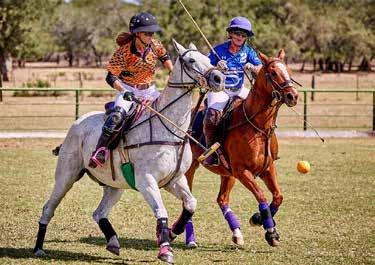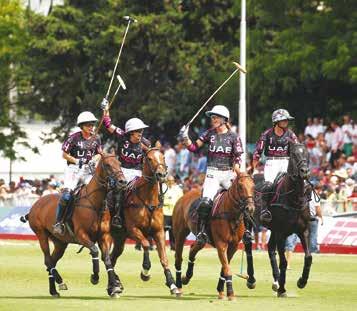
8 minute read
Playing Tips with Rege Ludwig: Use of the Player’s Lower Legs
Renowned polo coach, Rege Ludwig gives his expert advice on how to get more out of your game
Your lower legs serve two major functions; the first is to energise the horse’s hindquarters. From that perspective, you should squeeze, tap, or kick the horse’s sides with your lower legs to generate energy in the horse’s hindquarters that is equal to the intensity with which you want the horse to execute whatever the manoeuvre might be i.e., accelerate, decelerate, or change direction.
Advertisement
The second function is to serve as a counterbalancing mechanism to your upper body. For example, when moving your upper body forward and down to accelerate, your lower legs should move back and up correspondingly to counterbalance the movement of your upper body moving forward and down.
Because your feet ultimately affect how you use the rest of your body, a discussion on the use of your lower legs would not be complete without mentioning the use of the feet. 1. By way of your toes being turned up and your heels being pushed down, your feet affect how strongly you can grip with your upper legs to establish and maintain a secure and stable riding and/or hitting platform, i.e., Toes up/ Heels down, and the Pyramid Affect
2. Your feet affect how you can use your lower legs as an energizing source for the purpose of developing power in the horse’s hindquarters, i.e., squeeze, tap, or kick. 3. Your feet and lower legs affect your ability to control your upper body balance and movement in a counter balancing manner, similar to the way you use a Joy Stick.
I feel quite safe in stating that if polo players were to use their lower legs more correctly, including feet, the overall level of polo throughout the world would improve perceptively. That is true because, how you use your lower legs directly affects the balance and the stability of your upper body, and the intensity with which the horse responds to you as you are requesting of the horse to accelerate, decelerate, or change direction.
Your lower legs are used primarily as an energizing source to create impulsion in the horse’s hindquarters for the purpose of driving the back legs forward and under the horse’s body. The back legs being forward and under the horse’s body is significant from the perspective that one of the more critical aspects of a good accelerate, decelerate or change in direction manoeuvre is for the horse to be able to balance and support itself throughout any of those manoeuvres.
Contrary to the generally accepted belief that the player’s feet and lower legs should be forward during the decelerating process, I strongly urge you to consider that your lower legs should be back to where they are at least to the front and lower edge of the Sweet Spot, which is an area along the horse’s sides that your lower legs move within when requesting of the horse to accelerate, decelerate, or change direction. A principal reason for your lower legs being back is to energize the horse’s hind quarters; which, they cannot do when they are forward toward the horse’s shoulders.


Toes up/Heels down Joy Stick Affect

The Sweet Spot
Continuing with the cannot line of thinking, you cannot pull the horse’s front end back with your hands when decelerating the horse. What you can do, however, is: drive the horse’s hind legs forward with your lower legs, while supporting the front end with a degree of pressure on the reins that is consistent with the intensity of the desired decelerating effort.
Accelerate vs Decelerate
Do not be confused with the statement that your lower legs should be back to decelerate the polo horse, when I have said that they
should be back and up along the horse’s sides to accelerate the horse.
An appropriate question at this point could be, how in the world can the lower legs be used in the same manner to accomplish two completely opposite manoeuvres, i.e., accelerate versus decelerate?
The answer is quite simple. The horse’s hind legs should be forward and under its body for the purpose of both accelerating and decelerating. From that perspective, your lower legs are used to energize the horse’s hind quarters for the purpose of driving its back legs forward and under its body in a manner that is conducive to both accelerating and decelerating.
For the purpose of accelerating, your lower legs should be back and up within the Sweet Spot to the degree of the desired rate of acceleration. The faster the rate of acceleration, the further back and up your lower legs should be within the Sweet Spot.
For the purpose of decelerating, your lower legs should be back to the point of your toes being under the center of your knees. At that point, your lower legs are back far enough to contact the horse’s sides with sufficient power to drive its hind legs forward to decelerate.
Lower Leg: Pyramid Effect
The majority of your weight in the stirrups should be on the medial, or inner, side of each foot, i.e., the big ball. The majority of the weight in the stirrups should be there for the purpose of establishing and maintaining a wide base of support, i.e., Pyramid Effect. By having the majority of the weight in the stirrups on the medial side of your feet, your upper legs are being pushed in towards the horse. That, in turn, increases your upper leg gripping strength, which enhances upper body balance control.
To accomplish having the weight in the stirrups on the medial side of your feet; turn your heels out and away from the horse sides and push your feet out and away ever so slightly further. That manoeuvre also causes your upper legs to turn in towards the horse’s shoulders to be creating a strong upper leg gripping effort. Once those two things have been done, lift your little toes laterally up and away from the horse’s sides to the point that the soles of your boots are beginning to face out and away from the horse’s sides.

Accelerate


Upper leg turned in/Heels out
Lower Legs: Sweet Spot
I am well aware that a majority of people who ride horses are not accustomed to having their lower legs back and up along the horse’s sides to the degree that the polo player must, at times, have their lower legs positioned. However, I predict a most pleasant and productive experience for the polo player who learns to apply their lower legs appropriately back and up along the horse’s sides within the area of the Sweet Spot when the situation necessitates; such as accelerating.
The Sweet Spot starts just behind the girth approximately twelve inches up from the bottom of the horse’s visceral cavity. The front and lower edge of the Sweet Spot is where your lower legs fit when in the half-seat position. From that point, the Sweet Spot extends back and up along the horses’ sides towards the hipbones. With your lower legs properly placed within the forward half seat position, your toes should be under the centre of your knees. With your lower legs back that far, the back inside edge of your lower legs will be contacting the front and lower edge of the Sweet Spot. With your lower legs in that position, you will have enough power in your lower legs to energize the horse’s hind quarters for the purpose of driving its hind legs forward to decelerate. Reference above Sweet Spot illustration Relative to accelerating, as your lower legs move back and up towards the horse’s hipbones they are getting into a more sensitive, or sweeter area on the horse’s sides, hence the term Sweet Spot. Because of that, the horse is more responsive to the use of the player’s lower legs, and will respond more readily as your lower legs get closer to the top of the Sweet Spot, near the horse’s hip bones. Many years ago, I asked a veterinarian why horses seem to be more sensitive, and become increasingly reactive, the further back and up along the horse’s sides the player’s lower legs apply pressure. His explanation was, “It is nature at work. On an animal of prey, such as a deer or a horse, that area is where a predator, such as a lion, will try to grab when attacking. Consequently, animals of prey are instinctively more reactive to that part of their body being molested and as a result, they run faster”. I fully realize that use of the lower legs is a topic that polo players generally give little consideration to. However, because of the response the lower legs illicit from the polo horse, being aware of that effect is a topic well worth whatever consideration you may put into understanding it, and using it. When all is said and done, a foot of space or a quarter of a second of time can be the difference between winning or losing a play. And, the way you use lower legs directly affects the use of space and time and in the results of winning or losing a play.










